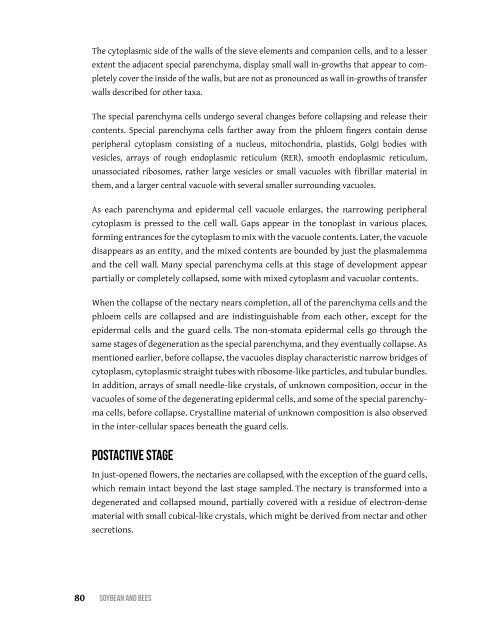SOYBEAN and BEES
BFhV4z
BFhV4z
You also want an ePaper? Increase the reach of your titles
YUMPU automatically turns print PDFs into web optimized ePapers that Google loves.
The cytoplasmic side of the walls of the sieve elements <strong>and</strong> companion cells, <strong>and</strong> to a lesser<br />
extent the adjacent special parenchyma, display small wall in-growths that appear to completely<br />
cover the inside of the walls, but are not as pronounced as wall in-growths of transfer<br />
walls described for other taxa.<br />
The special parenchyma cells undergo several changes before collapsing <strong>and</strong> release their<br />
contents. Special parenchyma cells farther away from the phloem fingers contain dense<br />
peripheral cytoplasm consisting of a nucleus, mitochondria, plastids, Golgi bodies with<br />
vesicles, arrays of rough endoplasmic reticulum (RER), smooth endoplasmic reticulum,<br />
unassociated ribosomes, rather large vesicles or small vacuoles with fibrillar material in<br />
them, <strong>and</strong> a larger central vacuole with several smaller surrounding vacuoles.<br />
As each parenchyma <strong>and</strong> epidermal cell vacuole enlarges, the narrowing peripheral<br />
cytoplasm is pressed to the cell wall. Gaps appear in the tonoplast in various places,<br />
forming entrances for the cytoplasm to mix with the vacuole contents. Later, the vacuole<br />
disappears as an entity, <strong>and</strong> the mixed contents are bounded by just the plasmalemma<br />
<strong>and</strong> the cell wall. Many special parenchyma cells at this stage of development appear<br />
partially or completely collapsed, some with mixed cytoplasm <strong>and</strong> vacuolar contents.<br />
When the collapse of the nectary nears completion, all of the parenchyma cells <strong>and</strong> the<br />
phloem cells are collapsed <strong>and</strong> are indistinguishable from each other, except for the<br />
epidermal cells <strong>and</strong> the guard cells. The non-stomata epidermal cells go through the<br />
same stages of degeneration as the special parenchyma, <strong>and</strong> they eventually collapse. As<br />
mentioned earlier, before collapse, the vacuoles display characteristic narrow bridges of<br />
cytoplasm, cytoplasmic straight tubes with ribosome-like particles, <strong>and</strong> tubular bundles.<br />
In addition, arrays of small needle-like crystals, of unknown composition, occur in the<br />
vacuoles of some of the degenerating epidermal cells, <strong>and</strong> some of the special parenchyma<br />
cells, before collapse. Crystalline material of unknown composition is also observed<br />
in the inter-cellular spaces beneath the guard cells.<br />
Postactive stage<br />
In just-opened flowers, the nectaries are collapsed, with the exception of the guard cells,<br />
which remain intact beyond the last stage sampled. The nectary is transformed into a<br />
degenerated <strong>and</strong> collapsed mound, partially covered with a residue of electron-dense<br />
material with small cubical-like crystals, which might be derived from nectar <strong>and</strong> other<br />
secretions.<br />
80 SoybeAn <strong>and</strong> bees






